

What is Learning Design? Learner-centred design and technology Technology is rapidly changing the way that we learn and teach.
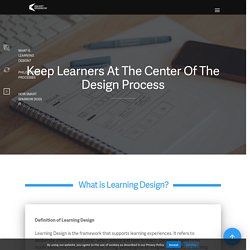
There are a range of tools at our disposal- new features are made available constantly and new tools are developed yearly –the landscape is getting more crowded. In recent years, there have been multiple attempts to explicate this software ecosystem, below is an attempt by Navitas, to bucket tools depending on the stage of the learning lifecycle they were designed for and impact. And it gets more complex, this graph doesn’t include the tools Graphic Designers, UX Designers, Software Developers use. Navita's Next Gen Learning Lifecycle At the end of the day the right technology for instructional design teams (aka courseware development teams) is a versatile and powerful tool that enables the creation of high-quality digital learning experiences that are beautiful, seamless, engaging and personal.
Learning design for information literacy Impact of the OU Learning Design Initiative (OULDI) project on skills integration into OU courses ALDinHE conference, PyramidApp - Tools - TIDE Research Group of Interactive and Distributed Technologies for Education. Description PyramidApp is a scalable technological approach facilitating flexible collaborative learning following Pyramid or Snowball collaborative learning flow pattern.

Using PyramidApp authoring tool, practitioners can design activities that can be enacted in any preferred education context. Students will use PyramidApp to access the activity and submit individual option (which can be a question, comment, suggestion, or even a link of a created resource) for a given task. Students will be able to collaboratively discuss and negotiate upon a common agreed option in groups and rate those options iteratively following a snowball or pyramid structure till the complete crowd reaches a global consensus on the most interesting option(s). The objective of the tool is to allow students to learn from peers in the process of proposing options, discussing and selecting the best option(s)! How it works Authoring: Activity enactment: PyramidApp is integrated within ILDE platform. [PDF] Diagrams of learning flow patterns' solutions as visual representations of refinable IMS Learning Design templates.
Skip to search formSkip to main content Diagrams of learning flow patterns' solutions as visual representations of refinable IMS Learning Design templates @inproceedings{HernndezLeo2008DiagramsOL, title={Diagrams of learning flow patterns' solutions as visual representations of refinable IMS Learning Design templates}, author={Davinia Hern{\'a}ndez-Leo and Eloy D.
![[PDF] Diagrams of learning flow patterns' solutions as visual representations of refinable IMS Learning Design templates](http://cdn.pearltrees.com/s/pic/th/solutions-representations-206676575)
Villasclaras-Fern{\'a}ndez and Juan I. Asensio-P{\'e}rez and Yannis A. Dimitriadis}, year={2008} } View PDF Share This Paper Figures, Tables, and Topics from this paper. e4innovation.com » Learning design. In this book I will argue that in today’s technologically rich context, where content and services are increasingly free, we need to rethink approaches to the design of learning activities and content.
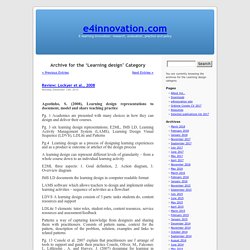
I introduce the concept of ‘open design’ and argue that making the design process more explicit and shareable will enable teachers to develop more effective learning contexts for learners and help make the intended design more explicit and shareable with other teachers and learners. It will help learners to make more sense of their educational provision and associated learning pathways. I will provide a number of illustrations of adopting an ‘open design’ approach, from a set of design representations through to the use of open, social and participatory media for sharing and discussing designs. The Internet and associated technologies have been around for around twenty years now. Networked access and computer ownership are now the norm. Designing learning and assessment in a digital age.
Assessment analytics. Projects taking part in our Assessment and Feedback Programme raised the profile of assessment analytics by evaluating the implementation of electronic assessment management (EMA) systems such as GradeMark and by exploring ways of using the assessment data such systems produce to evaluate and improve the quality of learning and teaching.
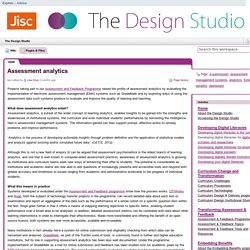
What does assessment analytics entail? Assessment analytics, a subset of the wider concept of learning analytics, enables insights to be gained into the strengths and weaknesses of institutional systems, the curriculum and even individual students’ performances by harvesting the intelligence held in assessment management systems. The information gained can then support prompt, effective action to remedy problems and improve performance. ASK Learning Designer Toolkit (ASK-LDT) 1 Definition ASK-LDT is a stand alone application for Microsoft Windows OS and it facilitates creation of Templates for Educational Design and Educational Scenarios based on the interconnection of Learning Activities following the IMS Learning Design Specification (IMS LD).
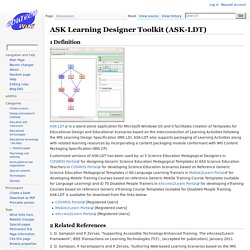
ASK-LDT also supports packaging of Learning Activities along with related learning resources by incorporating a content packaging module conformant with IMS Content Packaging Specification (IMS CP). COSMOS Portal [Registered Users] Mobile2Learn Portal [Registered Users] eAccess2Learn Portal [Registered Users] 2 Related References 1. 2. 3. 4. Design Tools & Support « Open University Learning Design Initiative. Over the last 4 years we have developed a range of tools, resources and activities.
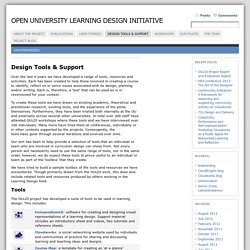
Each has been created to help those involved in creating a course to identify, reflect on or solve issues associated with its design, planning and/or writing. Each is, therefore, a ‘tool’ that can be used as is or reversioned for your context. To create these tools we have drawn on existing academic, theoretical and practitioner research, existing tools, and the experience of the pilots themselves. Furthermore, they have been trialled both internally at the OU and externally across several other universities. Keynote: Conole - Learning design - making practice explicit. Abstract.

7Cs Design and Delivery « Open University Learning Design Initiative. Episode 3: Teaching as design with Peter Goodyear by Melbourne CSHE. Pre-Design. Pre-Design is the first step in building an online course, and one that will guide the design and development process.
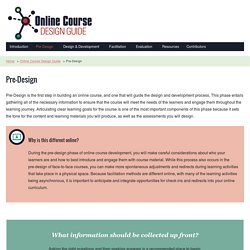
This phase entails gathering all of the necessary information to ensure that the course will meet the needs of the learners and engage them throughout the learning journey. Articulating clear learning goals for the course is one of the most important components of this phase because it sets the tone for the content and learning materials you will produce, as well as the assessments you will design. Why is this different online?
Templates. Learning Designs. Learning design: reflections upon the current landscape. Research in Learning Technology Supplement: ALT-C 2012 Conference Proceedings Yishay Mor*a and Brock Craftb aInstitute of Educational Technology, Open University, Milton Keynes, UK; bInstitute of Education, University of London, London, UK (Received 12 March 2012; final version received 15 June 2012; Published: 30 August 2012)
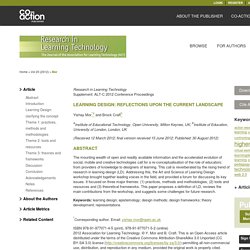
Laurillard2008Digital technologies. EoLChapter11. LD Websites. Toolsandtheories. Design Thinking for Educators. Construct%20an%20LD%20Sequence. Change.mooc.ca. MOOCs S1 Laurillard. Diana Laurillard – The SOLE Model & Toolkit. It is always a privilege to be listed with others whose work one admires. I was pointed recently to a page produced by Laura Heap at the London Metropolitan University in May 2014 on their eLearning Matrix pages. On a page where Laura outlines possible answers to the question “What models are there for blended and distance online learning delivery?” She has chosen to include my work here on the SOLE Model alongside some people that I deeply admire. Laura lists four different models (references on the London Met webpage) which each, in very different ways, seek to clarify dimensions of the challenge presented by distance and blended learning scenarios (something I have already written about on my personal blog).
Professor Terry Anderson at Athabasca University (Canada), alongside Randy Garrison, whilst at the University of Calgary back in the late 1990s and 2000s, developed a “community of inquiry model” as an instructional design model for e-learning. Bibliography Bakhtin, M. (1981). The Learning Design of MOOCs. I got some Gates funding for the MOOC Research Initiative to look at two things: completion data, and learning design MOOCs. The first part allowed Katy Jordan to finish the work she had started in mapping various factors from over 200 MOOCs that influence completion. You can see more of her work here, and I'll blog on that later. My part has been using the tools we've developed at the OU for learning design, building on Grainne Conole's work.
We use two main tools: the Activity Planner and the Module Map. The first maps student activity across 6 categories, eg assimilative, productive, etc. So far I've only done the Module Map applied to 14 MOOCs, chosen from a range of providers and to give both x and cMOOC types. The second representation is more interesting and maps the number of resources used under each of the four categories given above. Now there are lots of caveats around this. Open University Learning Design Initiative.
The OU Learning Design Initiative (OULDI) started with institutional strategic funding in 2007 and has been funded by JISC under the Curriculum Design programme since September 2008. Our work is focused around several key questions: Our aim is to develop and implement a methodology for learning design composed of tools, practice and other innovation that both builds upon, and contributes to, existing academic and practioner research. We have been working across several OU faculties and with 4 other universities to pilot curriculum design activities and relevant supporting tools and to contribute to the broader academic work in the subject. We have produced a range of tools which include: Additional outputs include: Learning, Design and Technology. Home - Learning Designs - Products of the AUTC project on ITC-based learning designs.